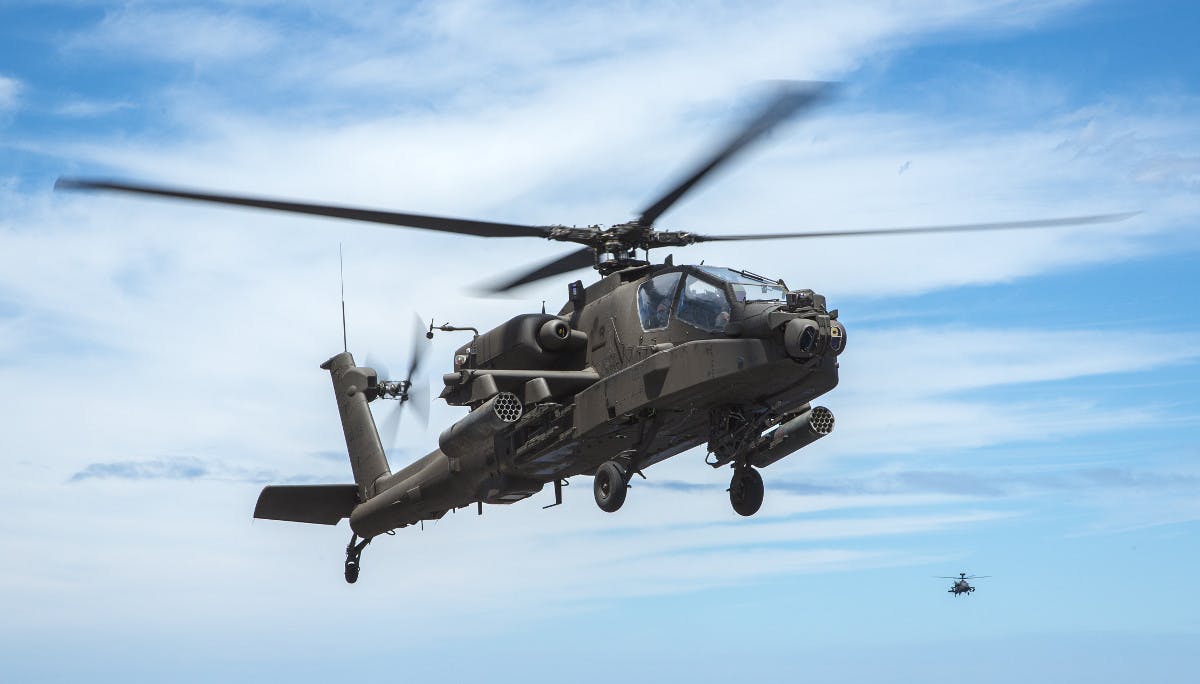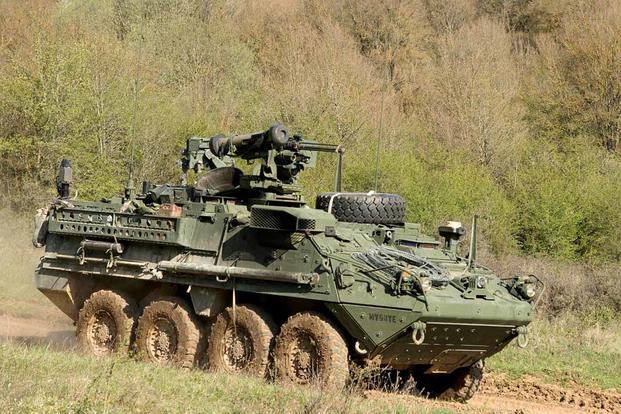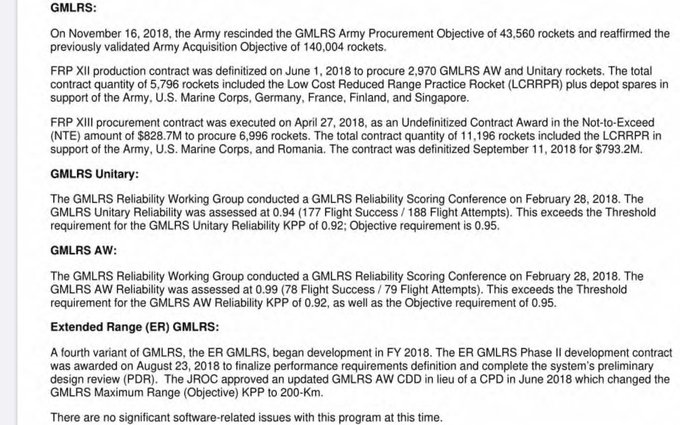Army Picks BAE Jammer To Kill Russian Missiles (Softly)
Army Picks BAE Jammer To Kill Russian Missiles (Softly)
If RAVEN succeeds in the next, more challenging round of tests, the BAE jammer will ultimately go on the 1980s-vintage M2 Bradley. That's a big part of the Army’s urgent push to protect American armored vehicles against Russian-made anti-tank missiles in widespread use around the world.
By SYDNEY J. FREEDBERG JR.on February 15, 2019 at 12:42 PM
100 Comments
25SHARES

M2 Bradley in Iraq
BAE Systems’ RAVEN jammer has won the Army’s “soft-kill rodeo”: six weeks of shooting live anti-tank guided missiles (ATGMs) at targets and seeing which of three competing countermeasures made them miss most. Now BAE advances to the next, more challenging round of tests in July, when its jammer will be installed on an actual M2 Bradley alongside the Israeli-made Iron Fist, a “hard kill” system that physically shoots down any incoming missiles that soft-kill systems can’t trick into going off course.
Now, the Army hasn’t committed to buy the BAE RAVEN yet. But fielding a new soft-kill system is a big part of the Army’s urgent push to protect American armored vehicles against Russian-made anti-tank missiles – and their many knock-offs – in widespread use with conventional militaries and guerrilla forces around the world.
Getting into the specifics requires serving up some acronym soup (we’re sorry). In the soft-kill tests at Redstone Army Test Center in Alabama, BAE’s RAVEN Multifunction Countermeasure (MFCM) beat Northrop Grumman’s Multifunction Electro-Optical System (MEOS) and the Israeli-made, Lockheed Martin-modified Color Light Operational Unit for Deflection (CLOUD). The next step is to install RAVEN on an actual Bradley for a “layered demonstration” that integrates both hard- and soft-kill systems on the same platform, coordinated by the Army-developed Modular Active Protection System (MAPS).
Parallel Programs
So far, the focus has been on hard-kill Active Protection Systems (APS), which are basically mini-missile defense systems that fire tiny projectiles or explosives at the incoming threat. After decades of dithering, the Army bought the only combat-proven hard-kill system in the Western world, the Rafael Trophy, in 2017 and began installing it on M1 Abrams heavy tanks. Last year, it picked the IMI Iron Fist to go on the M2 Bradley, a medium-weight, tank-like troop carrier, while starting over in its search for an APS to go on the lightweight wheeled Stryker.
But in parallel, with much less publicity, the Army has also been pursuing soft-kill systems. Soft-kill is less dramatic than hard, since it electronically blinds or tricks the incoming missile so it misses, rather than physically blowing it up. But the two approaches are complementary. In fact, you want your soft-kill jammer to be your first resort, since it never runs out of ammo, and save your hard-kill projectiles for threats that don’t fall for your electronic tricks.

Click graphic to expand
So it’s crucial to coordinate a vehicle’s hard and soft-kill systems, lest they double up unnecessarily on one threat while letting another through. That coordination, in turn, is the job of the Army’s Modular Active Protection System.
The MAPS program, in its current form, evolved from decades of Army efforts to develop its own comprehensive hard-and-soft-kill defense, initially for the Future Combat System vehicles cancelled in 2009. After Russian forces invaded Ukraine – including tanks with advanced active protection that stymied Ukrainian missile teams – the US Army decided the threat was so urgent it had to buy foreign-made hard-kill systems off the shelf ASAP, even if that meant picking different vendors for different vehicles.
But the service still kept MAPS going in the background. Its goal became developing an open architecture — the Modular APS Framework (MAF) — that could used on any current or future armored vehicle to plug-and-play the best radars, jammers, and hard-kill shooters from different vendors. That way, the Army can easily update vehicle protection with whatever new technology becomes available from any vendor.
The soft-kill rodeo was also the first field test for what’s called the MAPS Base Kit, which uses Lockheed Martin hardware and software to control all three vendors’ systems from the initial detection of the threat to its final defeat. The MAPS base kit, BAE’s RAVEN, and IMI’s Iron Fist will now all be wired together on an actual Bradley for the Layered Active Protection Demonstration, also at Redstone, which is scheduled for July-September this year.

Gen. John Murray, first chief of Army Futures Command, speaks at its formal activation in Austin.
Futures Command
So far, MAPS work has been run by the Army’s Ground Vehicle Systems Center, known until recently as TARDEC. The Detroit Arsenal-based outfit changed its name alongside its parent command, which went from RDECOM to Combat Capabilities Development Center (CCDC) when it became part of the new Army Futures Command.

Maj. Gen. Cedric Wins, commander of US Army Combat Capabilities Development Command (formerly RDECOM)
But CCDC and the Ground Vehicle center do R&D, not production, which requires very different skills. So actual acquisition of the MAPS Base Kit will be the job of the Army’s Product Manger for Vehicle Protection Systems, (PdM VPS), which will take over the base kit effort by the end of June.
Historically, such handoffs have been hard – the insider slang for the transition is “the valley of death.” But the whole point of the recent reorganization that created Army Futures Command is to have both R&D and acquisition programs reporting (with some legal caveats) to the same four-star commander, which didn’t happen in the old, fragmented bureaucracy.
Keeping the momentum on the Active Protection effort, which began before Army Futures Command stood up, will be one of the new command’s first big tests. But that’ll just be a warm-up for something much more ambitious effort: developing all-new Next Generation Combat Vehicles, both fully robotic and optionally manned, to replace the aging M2 Bradley altogether.
Army Picks BAE Jammer To Kill Russian Missiles (Softly)
If RAVEN succeeds in the next, more challenging round of tests, the BAE jammer will ultimately go on the 1980s-vintage M2 Bradley. That's a big part of the Army’s urgent push to protect American armored vehicles against Russian-made anti-tank missiles in widespread use around the world.
By SYDNEY J. FREEDBERG JR.on February 15, 2019 at 12:42 PM
100 Comments
25SHARES

M2 Bradley in Iraq
BAE Systems’ RAVEN jammer has won the Army’s “soft-kill rodeo”: six weeks of shooting live anti-tank guided missiles (ATGMs) at targets and seeing which of three competing countermeasures made them miss most. Now BAE advances to the next, more challenging round of tests in July, when its jammer will be installed on an actual M2 Bradley alongside the Israeli-made Iron Fist, a “hard kill” system that physically shoots down any incoming missiles that soft-kill systems can’t trick into going off course.
Now, the Army hasn’t committed to buy the BAE RAVEN yet. But fielding a new soft-kill system is a big part of the Army’s urgent push to protect American armored vehicles against Russian-made anti-tank missiles – and their many knock-offs – in widespread use with conventional militaries and guerrilla forces around the world.
Getting into the specifics requires serving up some acronym soup (we’re sorry). In the soft-kill tests at Redstone Army Test Center in Alabama, BAE’s RAVEN Multifunction Countermeasure (MFCM) beat Northrop Grumman’s Multifunction Electro-Optical System (MEOS) and the Israeli-made, Lockheed Martin-modified Color Light Operational Unit for Deflection (CLOUD). The next step is to install RAVEN on an actual Bradley for a “layered demonstration” that integrates both hard- and soft-kill systems on the same platform, coordinated by the Army-developed Modular Active Protection System (MAPS).
Parallel Programs
So far, the focus has been on hard-kill Active Protection Systems (APS), which are basically mini-missile defense systems that fire tiny projectiles or explosives at the incoming threat. After decades of dithering, the Army bought the only combat-proven hard-kill system in the Western world, the Rafael Trophy, in 2017 and began installing it on M1 Abrams heavy tanks. Last year, it picked the IMI Iron Fist to go on the M2 Bradley, a medium-weight, tank-like troop carrier, while starting over in its search for an APS to go on the lightweight wheeled Stryker.
But in parallel, with much less publicity, the Army has also been pursuing soft-kill systems. Soft-kill is less dramatic than hard, since it electronically blinds or tricks the incoming missile so it misses, rather than physically blowing it up. But the two approaches are complementary. In fact, you want your soft-kill jammer to be your first resort, since it never runs out of ammo, and save your hard-kill projectiles for threats that don’t fall for your electronic tricks.

Click graphic to expand
So it’s crucial to coordinate a vehicle’s hard and soft-kill systems, lest they double up unnecessarily on one threat while letting another through. That coordination, in turn, is the job of the Army’s Modular Active Protection System.
The MAPS program, in its current form, evolved from decades of Army efforts to develop its own comprehensive hard-and-soft-kill defense, initially for the Future Combat System vehicles cancelled in 2009. After Russian forces invaded Ukraine – including tanks with advanced active protection that stymied Ukrainian missile teams – the US Army decided the threat was so urgent it had to buy foreign-made hard-kill systems off the shelf ASAP, even if that meant picking different vendors for different vehicles.
But the service still kept MAPS going in the background. Its goal became developing an open architecture — the Modular APS Framework (MAF) — that could used on any current or future armored vehicle to plug-and-play the best radars, jammers, and hard-kill shooters from different vendors. That way, the Army can easily update vehicle protection with whatever new technology becomes available from any vendor.
The soft-kill rodeo was also the first field test for what’s called the MAPS Base Kit, which uses Lockheed Martin hardware and software to control all three vendors’ systems from the initial detection of the threat to its final defeat. The MAPS base kit, BAE’s RAVEN, and IMI’s Iron Fist will now all be wired together on an actual Bradley for the Layered Active Protection Demonstration, also at Redstone, which is scheduled for July-September this year.

Gen. John Murray, first chief of Army Futures Command, speaks at its formal activation in Austin.
Futures Command
So far, MAPS work has been run by the Army’s Ground Vehicle Systems Center, known until recently as TARDEC. The Detroit Arsenal-based outfit changed its name alongside its parent command, which went from RDECOM to Combat Capabilities Development Center (CCDC) when it became part of the new Army Futures Command.

Maj. Gen. Cedric Wins, commander of US Army Combat Capabilities Development Command (formerly RDECOM)
But CCDC and the Ground Vehicle center do R&D, not production, which requires very different skills. So actual acquisition of the MAPS Base Kit will be the job of the Army’s Product Manger for Vehicle Protection Systems, (PdM VPS), which will take over the base kit effort by the end of June.
Historically, such handoffs have been hard – the insider slang for the transition is “the valley of death.” But the whole point of the recent reorganization that created Army Futures Command is to have both R&D and acquisition programs reporting (with some legal caveats) to the same four-star commander, which didn’t happen in the old, fragmented bureaucracy.
Keeping the momentum on the Active Protection effort, which began before Army Futures Command stood up, will be one of the new command’s first big tests. But that’ll just be a warm-up for something much more ambitious effort: developing all-new Next Generation Combat Vehicles, both fully robotic and optionally manned, to replace the aging M2 Bradley altogether.

















 INTELLIPUS@intellipus
INTELLIPUS@intellipus












 Air Power@MIL_STD
Air Power@MIL_STD
